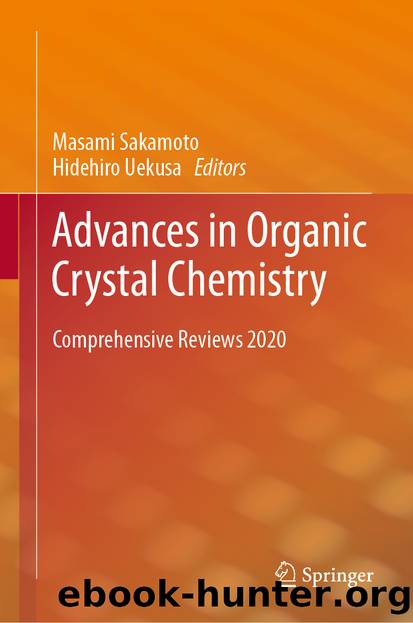Advances in Organic Crystal Chemistry by Unknown

Author:Unknown
Language: eng
Format: epub
ISBN: 9789811550850
Publisher: Springer Singapore
13.2.3 Hybridization of PDA Nanocrystal Fibers
PDA core-Ag shell-type hybridized NCs have been fabricated as described in the previous Sect. 13.1.3. The hybridization of silica-coated PDA NCFs as a core and gold (Au) NPs as a shell will be discussed in this sub-section. The LSPR peak of Au NPs (λAu, LSPR = ca. 500–550 nm) [30] is close to the EAP of PDA (PDA bulk crystal, PDA NCs, and PDA NCFs) (λPDA, EAP = ca. 600–700 nm, including phonon-side band) [10–12]. So, the strong and peculiar optoelectronic interactions would be emerged at the core–shell interface [31], rather than Ag NPs (λAg, LSPR = ca. 390–400 nm). This would expectedly lead to the enhancement of NLO properties [32], which is due to typically so-called excitation enhancement [23]. The surface of silica-coated PDA NCFs was further modified chemically by using silane-coupling agent (APTES: 3-aminopropyltriethoxysilane), so that amino-functional groups introduced on the surface of silica layer could control the adsorption amounts of Au NPs [33, 34]. After adding Au nano-seed (2–3 nm in size), aqueous solution of Au ion (Au3+) added was reduced mildly by using reducing agent of formaldehyde (HCHO). Here, Au nano-seed was prepared by mixing an aqueous solution containing a given amount of tetrachloroauric (III) acid (H[AuCl]4), sodium hydroxide (NaOH), and tertakis(hyroxymethyl)phosphonium chloride (THPC) [35]. On the other hand, aqueous solution of Au3+ was obtained by the incubating the mixture of H[AuCl]4 aq. and potassium carbonate (K2CO3) aq. under dark condition at ca. 5 °C for three days [33]. Furthermore, the previously Pt-sputtered filter substrate was employed, when hybridized PDA NCFs was characterized with SEM observation without using the conventional Pt-sputtering treatment. One can clearly observe the deposited Au NPs, because Au NPs are distinguished from Pt NPs on the filter substrate.
Au NPs have been finely deposited on the surface of amino-terminated silica-coated PDA NCFs, that is, PDA NCFs hybridized with Au NPs, and the deposition amount (or coverage ratio) of Au NPs was controlled and tuned successfully with increasing the injected amount of aqueous solution of Au3+ (Fig. 13.7). Interestingly, the size of the deposited Au NPs was not so changed, and only the deposition amount was multiplied. In addition, HAADF-STEM images and the corresponding profile of elementary mapping were also observed to further clarify the deposition nanostructure of Au NPs in hybridized PDA NCFs (Fig. 13.8). Au NPs were deposited randomly and almost isolated in the lower coverage ratio, whereas the Au NPs were densely located and connected partially with each other in the case of high coverage ratio.
Fig. 13.7SEM images before and after the deposition of Au NPs as a shell on the surface of amino-terminated silica-coated PDA NCFs. The deposition amounts of Au NPs increased from a–c, and the thickness of silica layer was about 10 nm in any case
Download
This site does not store any files on its server. We only index and link to content provided by other sites. Please contact the content providers to delete copyright contents if any and email us, we'll remove relevant links or contents immediately.
| Automotive | Engineering |
| Transportation |
Whiskies Galore by Ian Buxton(41532)
Introduction to Aircraft Design (Cambridge Aerospace Series) by John P. Fielding(32890)
Small Unmanned Fixed-wing Aircraft Design by Andrew J. Keane Andras Sobester James P. Scanlan & András Sóbester & James P. Scanlan(32574)
Craft Beer for the Homebrewer by Michael Agnew(17935)
Turbulence by E. J. Noyes(7702)
The Complete Stick Figure Physics Tutorials by Allen Sarah(7143)
Kaplan MCAT General Chemistry Review by Kaplan(6597)
The Thirst by Nesbo Jo(6439)
Bad Blood by John Carreyrou(6277)
Modelling of Convective Heat and Mass Transfer in Rotating Flows by Igor V. Shevchuk(6225)
Learning SQL by Alan Beaulieu(6037)
Weapons of Math Destruction by Cathy O'Neil(5832)
Man-made Catastrophes and Risk Information Concealment by Dmitry Chernov & Didier Sornette(5650)
Digital Minimalism by Cal Newport;(5392)
Life 3.0: Being Human in the Age of Artificial Intelligence by Tegmark Max(5188)
iGen by Jean M. Twenge(5163)
Secrets of Antigravity Propulsion: Tesla, UFOs, and Classified Aerospace Technology by Ph.D. Paul A. Laviolette(4994)
Design of Trajectory Optimization Approach for Space Maneuver Vehicle Skip Entry Problems by Runqi Chai & Al Savvaris & Antonios Tsourdos & Senchun Chai(4843)
Electronic Devices & Circuits by Jacob Millman & Christos C. Halkias(4749)
